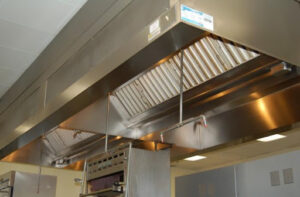A scheduled cleaning program prevents excessive buildup of grease in the hood, duct work
and fan. Grease accumulations lead to an increased fire risk. Semi-annual cleaning of the
ventilation system is often recommended; however, this is not an effective cleaning schedule
as the amount of potential grease accumulations varies drastically based on the type and
intensity of cooking. The NFPA 96 requires cleaning intervals based on the type and frequency
of cooking.
| Type of Cooking Volume | Inspection Frequency |
| Solid fuel cooking operations (wood burners) | Monthly |
| High-volume cooking operations (24-hour cooking, charbroiling, or wok cooking) | Quarterly |
| Systems serving moderate-volume cooking operations | Semi-annually |
| Systems serving low-volume cooking operations (churches, day camps, seasonal businesses, or senior centers) | Annually |
Ventilation systems should be cleaned by a professional service that specializes in commercial
cooking ventilation systems as they can be difficult to clean due to the large number of
concealed spaces. Contractors must be able to gain access to the interior of the duct work to
properly clean the system. NFPA 96 chapter 7 outlines the requirements for access panels.
Access panels are designed to allow interior cleaning without damaging the integrity of the
metal duct work. Briefly stated, some of the basic requirements are as follows:
- Multi-story vertical ducts require one access panel per floor
- Horizontal ducts shall have at least one 20” opening for personnel access
- Openings of sufficient size to permit thorough cleaning every 12ft
- For hoods with dampers, an access panel for cleaning and inspection shall be provided in the duct or hood within 18” of damper
It is also a good practice for the baffles and grease pans to be cleaned daily.

There are an estimated 5,600 restaurant fires reported annually, resulting in over $116M in property damage. *
Most Common Causes of Fires in Restaurants**
- Cooking Equipment is responsible for 57% of restaurant fires.
- Heating Equipment is responsible for 10% of restaurant fires.
- Electrical distribution and lighting equipment is responsible for 7% of restaurant fires
- Smoking is responsible for 7%
- Arson is responsible for 5%
- Failure to keep a clean kitchen was a factor in approximately 22% of fires
*National Fire Incident Reporting System (NFIRS)
** National Fire Protection Association (NFPA)
Includes content provided by Mutual Boiler Re
Hospitality Insurance Group
106 Southville Road, Southborough, MA 01772
www.hmic.com
877-366-1140
